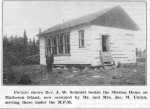Page
1 | Page 2 | Page
3 | Page 4 | Page
5 | Page 6
Mennonite
Pioneer Missions had its roots in the Bergthaler Mennonite Church
of Manitoba. In the 1930s, people from this church felt the need
for their own mission program. In 1938, they held a missions festival.
Two years later they formed the Bergthaler Missions Committee to
investigate areas of need and potential service. Their first attempt
was a school for orphans in Mexico called “The Home of the Good
Shepherd”. This mission ended after a few years because of disagreements
and problems with the Mexican government. Even while the Mexican
school was nearing its end, the Bergthaler church was planning a
new mission. This time, they looked closer to home. (Mennonite
Pioneer Mission list of representatives.)
Twenty-seven
Mennonite COs had chosen northern teaching as their alternative
service. When they returned home after the war, they had told church
leaders of the desperate situation. These communities, the COs said,
needed for social and missionary help.
 In the last portion of
this clip Henry Gerbrandt connects the CO expereince with the founding
of the Mennonite Pioneer Mission.
In the last portion of
this clip Henry Gerbrandt connects the CO expereince with the founding
of the Mennonite Pioneer Mission.
The
Bergthaler Mennonite Church accepted the challenge and established
six missions in northern Manitoba between 1948 and 1960. They were
Matheson Island (1948), Pauingassi (1955), Loon Straits (1955),
Cross Lake (1956), Manigotogan (1957), and Bloodvein (1960). Some
of these communities had Anglican, United, or Roman Catholic churches,
but they did not have regular services or resident priests. Historian
Peter Fast describes what the COs had seen in these communities.
“After
the war, these men saw the need for a true Gospel witness. Many
were alarmed at the type of Christians produced on old established
church mission fields. A form of godliness was produced, steeped
in formalities and rituals. This situation gave these men all the
more impetus to seek ways and means of challenging the neglected
Indian and Métis with the Gospel of Christ.” (Peter Fast,
“Mennonite Pioneer Mission: A Venture of Faith, p.3) (Read
the purpose statement in the Mennonite Pioneer Mission publication).
Some
of the natives were technically part of other churches, but they
didn't see their religion as connected with their everyday life.
For this reason, the Mennonites felt justified in sending missionaries
to these people. Besides being an opportunity for spiritual witness,
the Mennonite church also wanted to improve the living conditions
in these communities.
 |
| The mission house at Matheson Island, 1949. |
Jake
and Trudie Unrau started the mission on Matheson Island. In 1948,
it was home to 175 people. They relied on traditional sources of
income such as hunting, trapping, and fishing. The Unraus worked
to improve the religious and social lives of the people. (see
sample sermon notes) They organized the building of a
church and started religious education. Mennonite Pioneer Mission
also sent nurses to Matheson Island and encouraged teachers to volunteer.
The Unrau's took interest in the host culture and used an English-Cree
primer and vocabulary. (See sample
pages).
In
the 1973, the name of Mennonite Pioneer Mission changed to Native
Ministries. The terms “pioneer” and “mission” were no longer acceptable.
For many people, these words had unhappy connotations and implied
a superior sender speaking down to an inferior receiver. This understanding
did not accurately reflect the nature of the program, so the name
changed to Native Ministries. This change emphasized the equality
of all Christians.
Despite
the name, this had been the intention from the beginning. Jake Unrau
noted that he had much to learn from the natives. Even though he
had more formal education, he found that he was learning as much
as he was teaching. In Cross Lake, Ernie Sawatzky spent three weeks
on a trapline and attended traditional native dances to try to understand
the people better. This effort to understand native culture instead
of condemning it earned Sawatzky the respect of the people. In Manigotogan,
a Métis community, Jake Unrau organized the Wanipigow Producers
Co-op in 1963. This allowed fishers to sell their fish at higher
prices by presenting a united front.
Perhaps
the most successful mission was in Pauingassi. This small community
on Lake Winnipeg did not have formal reserve status. The government
had not provided a school and the members of the community were
isolated from the outside world. Only one person in the community
spoke English. The rest spoke Saulteaux (pronounced Soto). Alcohol
abuse was a problem, as was low employment.
Henry
and Elna Neufeld, former students at Canadian Mennonite Bible College
in Winnipeg went there to serve in 1956. Not only were they teachers
and preachers, but they also dispensed medical and legal advice,
and worked as mechanics and labourers. The most important reason
for their success, however, was their willingness to learn Saulteaux
so they could speak to the people in their own language. By 1976,
the resident missionary presence had ended. A number of natives
had been ordained as church leaders and now they were leading the
church in Pauingassi and reaching out to other native communities.
Today,
Native Ministries continues in a number of communities. It is committed
to both spiritual and social transformation. Although the name has
changed, the mission has remained the same from the time of the
COs.
Page
1 | Page 2 | Page
3 | Page 4 | Page
5 | Page 6 |


